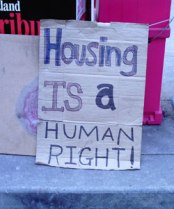
The number of social housing properties let on ‘social rents’ fell to a five year low in 2012/13 in England* figures released this month reveal.
Just 350,835 properties were rented out on secure or assured tenancies at social rents by councils and private sector providers – usually meaning housing associations – in the last year. Even adding in the new fixed term tenancies, with so-called affordable rents, the entire stock of new lettings hit a three year low, falling by around 15,000 properties since this government weren’t elected in 2010.
The amount of properties rented out by Local Authorities has been falling for years, however a small growth in Housing Association and other privately managed social housing had kept the numbers reasonably stable. That is no longer the case with local authority lettings down by 6% in 2012/13 and lettings by private providers falling by 3%.
Tenancies on affordable rents – which can be as high as 80% of of private sector rents – made up around a fifth of all general needs (meaning non-supported housing) tenancies started in 2012/13. According to the statistics from the Department of Communities and Local Government (DCLG) the average affordable rent is £114 a week across England and a whopping £160 in London. Traditional social rents averaged £80 per week across England.
The Government are hellbent or replacing what little social housing is left with ‘affordable’ tenancies which are anything but. These new tenancies can include ludicrous conditions such as both maximum and minimum income levels and even elements of workfare.
These figures come in the same month that The Guardian reported that 10,000 social houses have been flogged off since April 2012 under the right to buy scheme. As the supply of social housing shrinks, private sector rents are soaring in many parts of the country and house prices look set to do the same as. Local Housing Allowance, a benefit paid to to private sector tenants whether in or out of work, was first cut by Osborne in 2010 and then frozen below inflation in the Benefits Uprating Bill this year. Wages are stagnating and a raft of other cuts to benefits mean increasingly people find themselves dipping into rent money to keep the lights on or feed their children.
Every measure of homelessness is rising and the impacts of both the Benefit Cap and the Bedroom Tax have yet to be felt. The days of a council house for life on a rent which low income people could afford has now almost disappeared for new tenants entering social housing. Whilst much has been made of the plight of aspirational professionals hoping to get on the housing ladder, almost no-one – except those affected – has seemed to notice the demolition of housing provision for those at the very bottom.
That may all start to change. The number of people sleeping rough in London has doubled since 2008 and rocketed by 13% last year. Street homelessness is one of the most visible signs of poverty. When people see with their own eyes what Iain Duncan Smith has done, then any lingering support for his bungled and brutal welfare reforms may yet evaporate.
*Figures for Scotland, Wales and Northern Ireland are not collected by the DCLG.
This full figures can be found at: https://www.gov.uk/government/uploads/system/uploads/attachment_data/file/252344/REVISED_20131023_CORE_statistical_release_2012-13.pdf